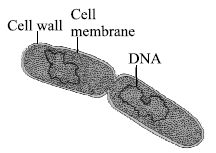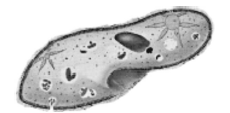Refer to CBSE Class 11 Biology Biological Classification MCQs Set C provided below available for download in Pdf. The MCQ Questions for Class 11 Biology with answers are aligned as per the latest syllabus and exam pattern suggested by CBSE, NCERT and KVS. Chapter 2 Biological Classification Class 11 MCQ are an important part of exams for Class 11 Biology and if practiced properly can help you to improve your understanding and get higher marks. Refer to more Chapter-wise MCQs for CBSE Class 11 Biology and also download more latest study material for all subjects
MCQ for Class 11 Biology Chapter 2 Biological Classification
Class 11 Biology students should refer to the following multiple-choice questions with answers for Chapter 2 Biological Classification in Class 11.
Chapter 2 Biological Classification MCQ Questions Class 11 Biology with Answers
Question: The most abundant prokaryotes helpful to humans in making curd from milk and in production of antibiotics are the ones categorised as
a) cyanobacteria
b) archaebacteria
c) chemosynthetic autotrophs
d) heterotrophic bacteria
Answer: d
Question: Peptidoglycan / Murein is present in the cell wall of
a) Animals
b) Plants
c) Fungi
d) Bacteria
Answer: d
Question: Old name of Blue green algae:
a) Cyanobacteria
b) Myxophyceae
c) Spectrum algae
d) None of the options
Answer: b
Question: There exists a close association between the alga and the fungus within a lichen. The fungus
a) provides protection, anchorage and absorption for the algae
b) provides food for the alga
c) fixes the atmospheric nitrogen for the alga
d) releases oxygen for the alga
Answer: a
Question: Which of the following organisms are known as chief producers in the oceans?
a) Dinoflagellates
b) Diatoms
c) Cyanobacteria
d) Euglenoids
Answer: b
Question: Auxospores and hormogonia are formed, respectively, by
a) some diatoms and several cyanobacteria
b) some cyanobacteria and many diatoms
c) several cyanobacteria and several diatoms
d) several diatoms and a few cyanobacteria
Answer: d
Question: One of the major components of cell wall of most fungi is
a) cellulose
b) hemicellulose
c) chitin
d) peptidoglycan.
Answer: c
Question: Which of the following statements is incorrect?
a) Yeasts have filamentous bodies with long thread like hyphae.
b) Morels and truffles are edible delicacies.
c) Claviceps is a source of many alkaloids and LSd
d) Conidia are produced exogenously and ascospores endogenously.
Answer: a
Question: Lichens are well known combination of an alga and a fungus where fungus has
a) a saprophytic relationship with the alga
b) an epiphytic relationship with the alga
c) a parasitic relationship with alga
d) a symbiotic relationship with alga
Answer: d
Question: Which of the following is a cyanobacterium ?
a) Nostoc
b) Chara
c) E. coli
d) Polysiphonia
Answer: a
Question: Which one of the following is true for fungi?
a) They lack a rigid cell wall.
b) They are heterotrophs.
c) They lack nuclear membrane.
d) They are phagotrophs.
Answer: b
Question: Which of the following statements is incorrect?
a) Prions consist of abnormally folded proteins.
b) Viroids lack a protein coat.
c) Viruses are obligate parasites.
d) Infective constituent in viruses is the protein coat.
Answer: d
Question: Lichens indicate SO2 pollution because they
a) show association between algae and fungi
b) grow faster than others
c) are sensitive to SO2
d) flourish in SO2 rich environment.
Answer: c
Question: Franklin Conrat demonstrated that RNA is genetic material in:
a) HIV
b) TMV
c) CMV
d) Mouse Sarcoma
Answer: b
Question: Bacteria lack alternation of generation because there is
a) neither syngamy nor reduction division
b) distinct chromosomes are absent
c) no conjugation
d) no exchange of genetic material.
Answer: a
Question: Which of the following shows coiled RNA strand and capsomeres?
a) Polio virus
b) Tobacco mosaic virus
c) Measles virus
d) Retrovirus
Answer: b
Question: Which of the following is a fungus?
a) Nostoc
b) E. coli
c) Yeast
d) Chara
Answer: c
Question: Bacterial leaf blight of rice is caused by a species
a) Alternaria
b) Erwinia
c) Xanthomonas
d) Pseudomonas.
Answer: d
Question: Cell wall is absent in
a) Mycoplasma
b) Nostoc
c) Aspergillus
d) Funaria
Answer: a
Question: Which one single organism or the pair of organisms is correctly assigned to its or their named taxonomic group?
a) Paramecium and Plasmodium belong to the same kingdom as that of Penicillium.
b) Lichen is a composite organism formed from the symbiotic association of an algae and a protozoan.
c) Yeast used in making bread and beer is a fungus.
d) Nostoc and Anabaena are examples of protista
Answer: c
Question: Which of the following organisms possesses characteristics of a plant and an animal?
a) Euglena
b) Paramecium
c) Bacteria
d) Mycoplasma
Answer: a
Question: Transduction in bacteria is mediated by
a) plasmid vectors
b) phage vectors
c) cosmids
d) F-factors.
Answer: b
Question: Plasmodium, the malarial parasite, belongs to class
a) sarcodina
b) ciliata
c) sporozoa
d) dinophyceae.
Answer: c
Question: Many blue-green algae occur in thermal springs (hot-water springs). The temperature tolerance of these algae have been attributed to their
a) mitochondrial structure
b) importance of homopolar bonds in their proteins
c) cell wall structure
d) modern cell organization.
Answer: c
Question: The main role of bacteria in the carbon cycle involves
a) chemosynthesis
b) digestion or breakdown of organic compounds
c) photosynthesis
d) assimilation of nitrogenous compounds.
Answer: b
Question: Match the following
a) Conjugation 1. Lederberg & Tatum
b) Transformation 2. Zinder & Lederberg
c) Transduction 3. Fredrick Griffith
a) A-1 B-3 C-2
b) A-3 B-1 C-2
c) A-2 B-3 C-1
d) A-2 B-1 C-3
Answer: b
Question: Find the correct matches:
List I List II
a) M13 bacteriophase 1. dsRNA
b) Rice Dwarf Virus 2. ssRNA
c) Cauliflower Mosaic Virus 3. ssDNA
d) Polio Virus 4. dsRNA
a) A-4 B-3 C-1 D-2
b) A-2 B-1 C-3 D-4
c) A-3 B-4 C-2 D-1
d) A-3 B-1 C-4 D-2
Answer: d
Question: Match the following
a) Peritrichous 1. One flagella at one end
b) Monotrichous 2. Tuft of flagella at one end
c) Amphitrichous 3. Two flagella at one end
d) Lopptrichous 4. Present on entrire surface
a) A-4 B-2 C-3 D-1
b) A-4 B-3 C-2 D-1
c) A-4 B-1 C-3 D-2
d) A-4 B-2 C-1 D-3
Answer: c
Image Based Questions
Question: What kind of reproduction is shown in this diagram?

Mode of Reproduction Conditions
a. Budding Favourable
b. Binary fission Favourable
c. Spore formation Unfavourable
d. Budding Unfavourable
Answer: b
Question: Identify the bacterial shape given in the figure.

a. Bacilli
b. Cocci
c. Spirilla
d. Vibrio
Answer: a
Question: The given organism belongs to which group?

a. Protozoans
b. Chrystophytes
c. Euglenoids
d. Diatoms
Answer: c
MCQs for Chapter 2 Biological Classification Biology Class 11
Expert teachers of studiestoday have referred to NCERT book for Class 11 Biology to develop the Biology Class 11 MCQs. If you download MCQs with answers for the above chapter you will get higher and better marks in Class 11 test and exams in the current year as you will be able to have stronger understanding of all concepts. Daily Multiple Choice Questions practice of Biology will help students to have stronger understanding of all concepts and also make them expert on all critical topics. After solving the questions given in the MCQs which have been developed as per latest books also refer to the NCERT solutions for Class 11 Biology. We have also provided lot of MCQ questions for Class 11 Biology so that you can solve questions relating to all topics given in each chapter. After solving these you should also refer to Class 11 Biology MCQ Test for the same chapter.
You can download the CBSE MCQs for Class 11 Biology Chapter 2 Biological Classification for latest session from StudiesToday.com
Yes, the MCQs issued by CBSE for Class 11 Biology Chapter 2 Biological Classification have been made available here for latest academic session
You can find CBSE Class 11 Biology Chapter 2 Biological Classification MCQs on educational websites like studiestoday.com, online tutoring platforms, and in sample question papers provided on this website.
To prepare for Chapter 2 Biological Classification MCQs, refer to the concepts links provided by our teachers and download sample papers for free.
Yes, there are many online resources that we have provided on studiestoday.com available such as practice worksheets, question papers, and online tests for learning MCQs for Class 11 Biology Chapter 2 Biological Classification

